Central Place Theory Based on Mobile Signal Data: The Case of Urban Parks in Beijing and Changsha
Abstract
1. Introduction
2. Materials and Methods
2.1. Study Area
2.2. Mobile Signaling Data
2.3. Park Service Areas
2.4. Analysis of Factors Influencing the Park Service Areas
3. Results
3.1. Dominant Influence Areas of Park Service
3.2. Factors Analysis for Park Grading
3.3. Factors Analysis for DIA on Each Level
4. Discussion
4.1. Data Reliability
4.2. The CPT Mode for Parks’ Recreational Services
5. Conclusions
Author Contributions
Funding
Data Availability Statement
Conflicts of Interest
References
- Dacey, M.F. The Geometry of Central Place Theory. Geogr. Ann. Ser. B Hum. Geogr. 1965, 47, 111–124. [Google Scholar]
- Cresswell, T. Place: An Introduction, 2nd ed.; John Wiley & Sons Inc.: New York, NY, USA, 2014; ISBN 9780470655627. [Google Scholar]
- Tammiksaar, E.; Jauhiainen, J.S.; Pae, T.; Ahas, R. Edgar Kant, Estonian Geography and the Reception of Walter Christaller’s Central Place Theory, 1933–1960. J. Hist. Geogr. 2018, 60, 77–88. [Google Scholar] [CrossRef]
- Setälä, H.; Francini, G.; Allen, J.A.; Jumpponen, A.; Hui, N.; Kotze, D.J. Urban Parks Provide Ecosystem Services by Retaining Metals and Nutrients in Soils. Environ. Pollut. 2017, 231, 451–461. [Google Scholar] [CrossRef] [PubMed]
- Buchel, S.; Frantzeskaki, N. Citizens’ Voice: A Case Study about Perceived Ecosystem Services by Urban Park Users in Rotterdam, the Netherlands. Ecosyst. Serv. 2015, 12, 169–177. [Google Scholar] [CrossRef]
- Kabisch, N.; Kraemer, R.; Brenck, M.E.; Haase, D.; Lausch, A.; Luttkus, M.L.; Mueller, T.; Remmler, P.; von Döhren, P.; Voigtländer, J.; et al. A Methodological Framework for the Assessment of Regulating and Recreational Ecosystem Services in Urban Parks under Heat and Drought Conditions. Ecosyst. People 2021, 17, 464–475. [Google Scholar] [CrossRef]
- Jameel, S.M.; Hussien, S.H. Urban Parks as a Green Enhancement of City Branding: Insights from Iraq. Cities 2023, 10, 107–122. [Google Scholar]
- Georgi, N.J.; Zafiriadis, K. The Impact of Park Trees on Microclimate in Urban Areas. Urban Ecosyst. 2006, 9, 195–209. [Google Scholar] [CrossRef]
- Palliwoda, J.; Kowarik, I.; von der Lippe, M. Human-Biodiversity Interactions in Urban Parks: The Species Level Matters. Landsc. Urban Plan. 2017, 157, 394–406. [Google Scholar] [CrossRef]
- Xu, L.; Yin, H.; Fang, J. Evaluating the Supply-Demand Relationship for Urban Green Parks in Beijing from an Ecosystem Service Flow Perspective. Urban For. Urban Green. 2023, 85, 127974. [Google Scholar]
- Wang, D.; Brown, G.; Liu, Y. The Physical and Non-Physical Factors That Influence Perceived Access to Urban Parks. Landsc. Urban Plan. 2015, 133, 53–66. [Google Scholar] [CrossRef]
- Lee, G.; Hong, I. Measuring Spatial Accessibility in the Context of Spatial Disparity between Demand and Supply of Urban Park Service. Landsc. Urban Plan. 2013, 119, 85–90. [Google Scholar] [CrossRef]
- Kaźmierczak, A. The Contribution of Local Parks to Neighbourhood Social Ties. Landsc. Urban Plan. 2013, 109, 31–44. [Google Scholar] [CrossRef]
- Wright Wendel, H.E.; Zarger, R.K.; Mihelcic, J.R. Accessibility and Usability: Green Space Preferences, Perceptions, and Barriers in a Rapidly Urbanizing City in Latin America. Landsc. Urban Plan. 2012, 107, 272–282. [Google Scholar] [CrossRef]
- Guan, C.; Song, J.; Keith, M.; Akiyama, Y.; Shibasaki, R.; Sato, T. Delineating Urban Park Catchment Areas Using Mobile Phone Data: A Case Study of Tokyo. Comput. Environ. Urban Syst. 2020, 81, 101474. [Google Scholar] [CrossRef]
- Guo, S.; Yang, G.; Pei, T.; Ma, T.; Song, C.; Shu, H.; Du, Y.; Zhou, C. Analysis of Factors Affecting Urban Park Service Area in Beijing: Perspectives from Multi-Source Geographic Data. Landsc. Urban Plan. 2019, 181, 103–117. [Google Scholar] [CrossRef]
- Chen, Y.; Liu, X.; Gao, W.; Wang, R.Y.; Li, Y.; Tu, W. Emerging Social Media Data on Measuring Urban Park Use. Urban For. Urban Green. 2018, 31, 130–141. [Google Scholar] [CrossRef]
- Ullah, H.; Wan, W.; Haidery, S.A.; Khan, N.U.; Ebrahimpour, Z.; Muzahid, A.A.M. Spatiotemporal Patterns of Visitors in Urban Green Parks by Mining Social Media Big Data Based upon WHO Reports. IEEE Access 2020, 8, 39197–39211. [Google Scholar] [CrossRef]
- Donahue, M.L.; Keeler, B.L.; Wood, S.A.; Fisher, D.M.; Hamstead, Z.A.; McPhearson, T. Using Social Media to Understand Drivers of Urban Park Visitation in the Twin Cities, MN. Landsc. Urban Plan. 2018, 175, 1–10. [Google Scholar] [CrossRef]
- Gu, C.; Wei, Y.D.; Cook, I.G. Planning Beijing: Socialist City, Transitional City, and Global City. Urban Geogr. 2015, 36, 905–926. [Google Scholar] [CrossRef]
- Gan, L.; Feng, C. Study on the Spatial Differentiation and Temporal Evolution of Urban Land Price: Evidence from Beijing. In Proceedings of the 19th International Symposium on Advancement of Construction Management and Real Estate; Springer: Berlin/Heidelberg, Germany, 2015; pp. 693–706. [Google Scholar]
- Tian, G.; Wu, J.; Yang, Z. Spatial Pattern of Urban Functions in the Beijing Metropolitan Region. Habitat Int. 2010, 34, 249–255. [Google Scholar] [CrossRef]
- Ma, M.; Lu, Z.; Sun, Y. Population Growth, Urban Sprawl and Landscape Integrity of Beijing City. Int. J. Sustain. Dev. World Ecol. 2008, 15, 326–330. [Google Scholar]
- Zhou, G.; He, Y. The Influencing Factors of Urban Land Expansion in Changsha. J. Geogr. Sci. 2007, 17, 487–499. [Google Scholar]
- The People’s Government of Beijing Municipality. Beijing Municipal Master Plan (2016–2035); The People’s Government of Beijing Municipality: Beijing, China, 2017. Available online: https://www.beijing.gov.cn/gongkai/guihua/wngh/cqgh/201907/t20190701_100008.html (accessed on 21 February 2025).
- The People’s Government of Hunan Province. Changsha Municipal Plan (2003–2020) (2014 Revision); The People’s Government of Hunan Province: Changsha, China, 2014. Available online: https://www.hunan.gov.cn/xxgk/fzgh/201408/t20140806_4902778.html (accessed on 21 February 2025).
- GB/T51346-2019; Green Space Standard for Urban Systematic Planning. China Architecture & Building Press: Beijing, China, 2019.
- Thatcher, J.; Shears, A.; Eckert, J. Thinking Big Data in Geography: New Regimes, New Research; University of Nebraska Press: Lincoln, NE, USA, 2018; ISBN 1496205375. [Google Scholar]
- Kandt, J.; Batty, M. Smart Cities, Big Data and Urban Policy: Towards Urban Analytics for the Long Run. Cities 2021, 109, 102992. [Google Scholar]
- Hao, J.; Zhu, J.; Zhong, R. The Rise of Big Data on Urban Studies and Planning Practices in China: Review and Open Research Issues. J. Urban Manag. 2015, 4, 92–124. [Google Scholar]
- Van Meeteren, M.; Poorthuis, A. Christaller and “Big Data”: Recalibrating Central Place Theory via the Geoweb. Urban Geogr. 2018, 39, 122–148. [Google Scholar]
- Lyu, F.; Zhang, L. Using Multi-Source Big Data to Understand the Factors Affecting Urban Park Use in Wuhan. Urban For. Urban Green. 2019, 43, 126367. [Google Scholar]
- Guo, H.; Luo, Z.; Li, M.; Kong, S.; Jiang, H. A Literature Review of Big Data-Based Urban Park Research in Visitor Dimension. Land 2022, 11, 864. [Google Scholar] [CrossRef]
- Zhai, Y.; Wu, H.; Fan, H.; Wang, D. Using Mobile Signaling Data to Exam Urban Park Service Radius in Shanghai: Methods and Limitations. Comput. Environ. Urban Syst. 2018, 71, 27–40. [Google Scholar]
- Taylor, P.J. Urban Economics in Thrall to Christaller: A Misguided Search for City Hierarchies in External Urban Relations. Environ. Plan. A 2009, 41, 2550–2555. [Google Scholar]
- Ozuduru, B.H.; Webster, C.J.; Chiaradia, A.J.F.; Yucesoy, E. Associating Street-Network Centrality with Spontaneous and Planned Subcentres. Urban Stud. 2021, 58, 2059–2078. [Google Scholar]
- Openshaw, S.; Veneris, Y. Numerical Experiments with Central Place Theory and Spatial Interaction Modelling. Environ. Plan. A 2003, 35, 1389–1403. [Google Scholar]
- Biernacka, M.; Kronenberg, J.; Łaszkiewicz, E. An Integrated System of Monitoring the Availability, Accessibility and Attractiveness of Urban Parks and Green Squares. Appl. Geogr. 2020, 116, 102152. [Google Scholar]
- Stoianov, I.; Chapra, S.; Maksimovic, C. A Framework Linking Urban Park Land Use with Pond Water Quality. Urban Water 2000, 2, 47–62. [Google Scholar]
- González, P.A. Cultural Parks and National Heritage Areas: Assembling Cultural Heritage, Development and Spatial Planning; Cambridge Scholars Publishing: Newcastle, UK, 2013; ISBN 1443854123. [Google Scholar]
- Cranz, G.; Boland, M. Defining the Sustainable Park: A Fifth Model for Urban Parks. Landsc. J. 2004, 23, 102–120. [Google Scholar]
- Gu, X.; Tao, S.; Dai, B. Spatial Accessibility of Country Parks in Shanghai, China. Urban For. Urban Green. 2017, 27, 373–382. [Google Scholar] [CrossRef]
- Wu, C.; Gao, F.; Ye, X.; He, Q. Unraveling the Impact of Urban Form on Location’s Irreplaceability: An Analysis from the Perspective of Spatiotemporal Heterogeneity. Trans. GIS 2024, 28, 701–725. [Google Scholar]
- Yuan, F.; Wei, Y.D.; Wu, J. Amenity Effects of Urban Facilities on Housing Prices in China: Accessibility, Scarcity, and Urban Spaces. Cities 2020, 96, 102433. [Google Scholar] [CrossRef]
- Su, M.M.; Wall, G. Exploring the Shared Use of World Heritage Sites: Residents and Domestic Tourists’ Use and Perceptions of the Summer Palace in Beijing. Int. J. Tour. Res. 2015, 17, 591–601. [Google Scholar]
- Su, M.M.; Wall, G. Residents’ Recreational and Social Use of and Perspectives on a World Heritage Site: Temple of Heaven, Beijing, China. J. Tour. Cult. Change 2017, 15, 15–36. [Google Scholar]
- Wang, N.; Lew, A.; Yu, L.; Ap, J.; Zhang, G. Chinese Vernacular Heritage as a Tourist Attraction: The Case of Beijing. In Tourism in China; Lew, A., Yu, L., Ap, J., Zhang, G., Eds.; Routledge: London, UK, 2003; pp. 51–62. [Google Scholar]
- Mohamed, A.A.; Kronenberg, J. Users’ Experiences of Park Accessibility and Attractiveness Based on Online Review Analytics. Sci. Rep. 2025, 15, 4268. [Google Scholar]
- Zhang, S.; Zhou, W. Recreational Visits to Urban Parks and Factors Affecting Park Visits: Evidence from Geotagged Social Media Data. Landsc. Urban Plan. 2018, 180, 27–35. [Google Scholar] [CrossRef]
- Wang, L.; Fan, H.; Wang, Y. Site Selection of Retail Shops Based on Spatial Accessibility and Hybrid BP Neural Network. ISPRS Int. J. Geo-Inf. 2018, 7, 202. [Google Scholar] [CrossRef]
- Hao, F.; Yang, Y.; Wang, S. Patterns of Location and Other Determinants of Retail Stores in Urban Commercial Districts in Changchun, China. Complexity 2021, 2021, 8873374. [Google Scholar] [CrossRef]
- Sevtsuk, A. Location and Agglomeration: The Distribution of Retail and Food Businesses in Dense Urban Environments. J. Plan. Educ. Res. 2014, 34, 374–393. [Google Scholar] [CrossRef]
- Walmsley, A. Greenways and the Making of Urban Form. Landsc. Urban Plan. 1995, 33, 81–127. [Google Scholar] [CrossRef]
- Gorgorova, Y.; Sarkisyants, V.M.G.; Sotnikova, M.A. The Principles of Sustainable Development of the Architectural Space of Linear Parks. In Proceedings of the IOP Conference Series: Materials Science and Engineering; IOP Publishing: Bristol, UK, 2020; Volume 753, p. 42025. [Google Scholar]
- Fischer, L.K.; Honold, J.; Botzat, A.; Brinkmeyer, D.; Cvejić, R.; Delshammar, T.; Elands, B.; Haase, D.; Kabisch, N.; Karle, S.J. Recreational Ecosystem Services in European Cities: Sociocultural and Geographical Contexts Matter for Park Use. Ecosyst. Serv. 2018, 31, 455–467. [Google Scholar] [CrossRef]
- Xiao, Y.; Wang, Z.; Li, Z.; Tang, Z. An Assessment of Urban Park Access in Shanghai—Implications for the Social Equity in Urban China. Landsc. Urban Plan. 2017, 157, 383–393. [Google Scholar] [CrossRef]
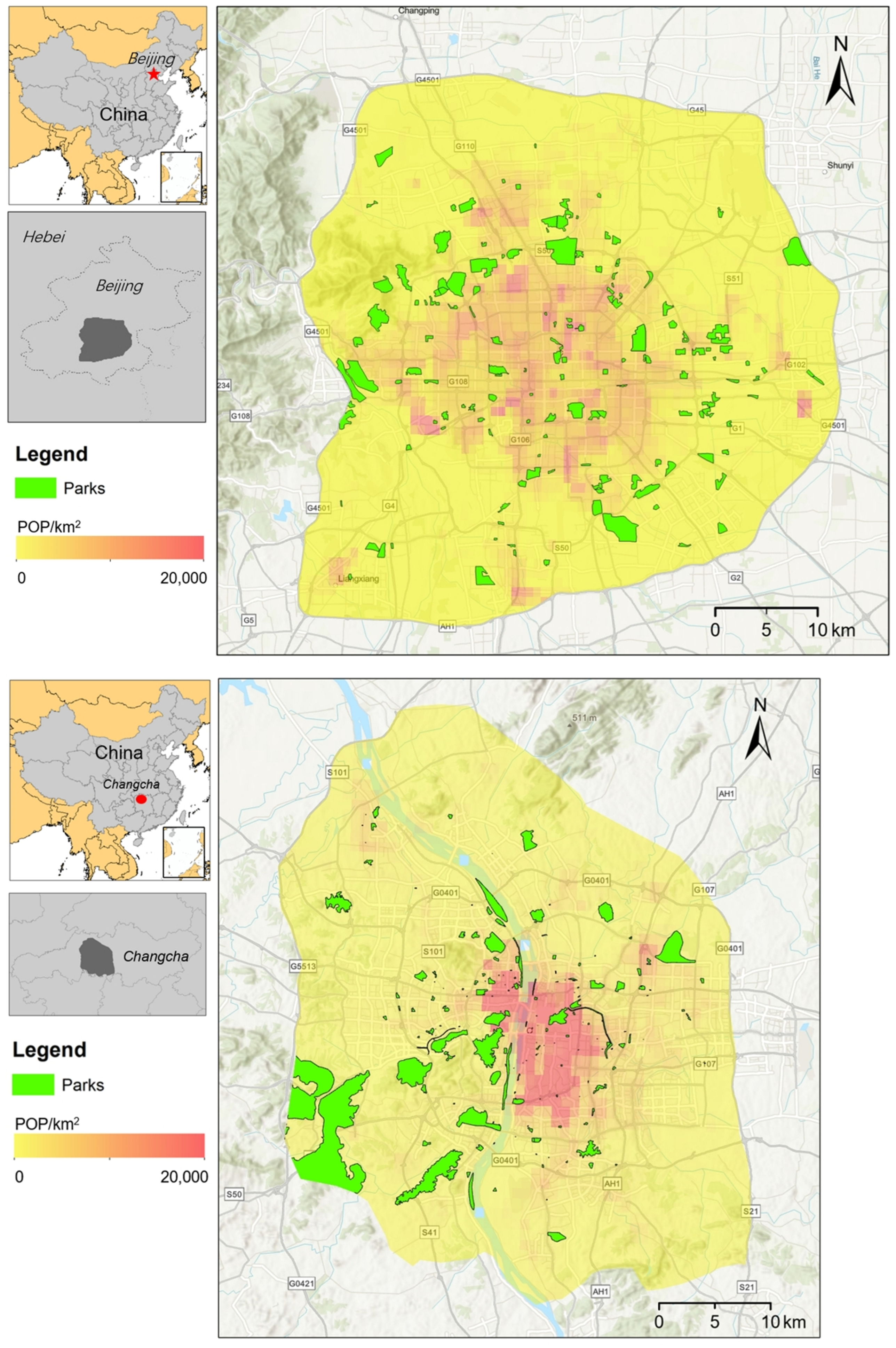


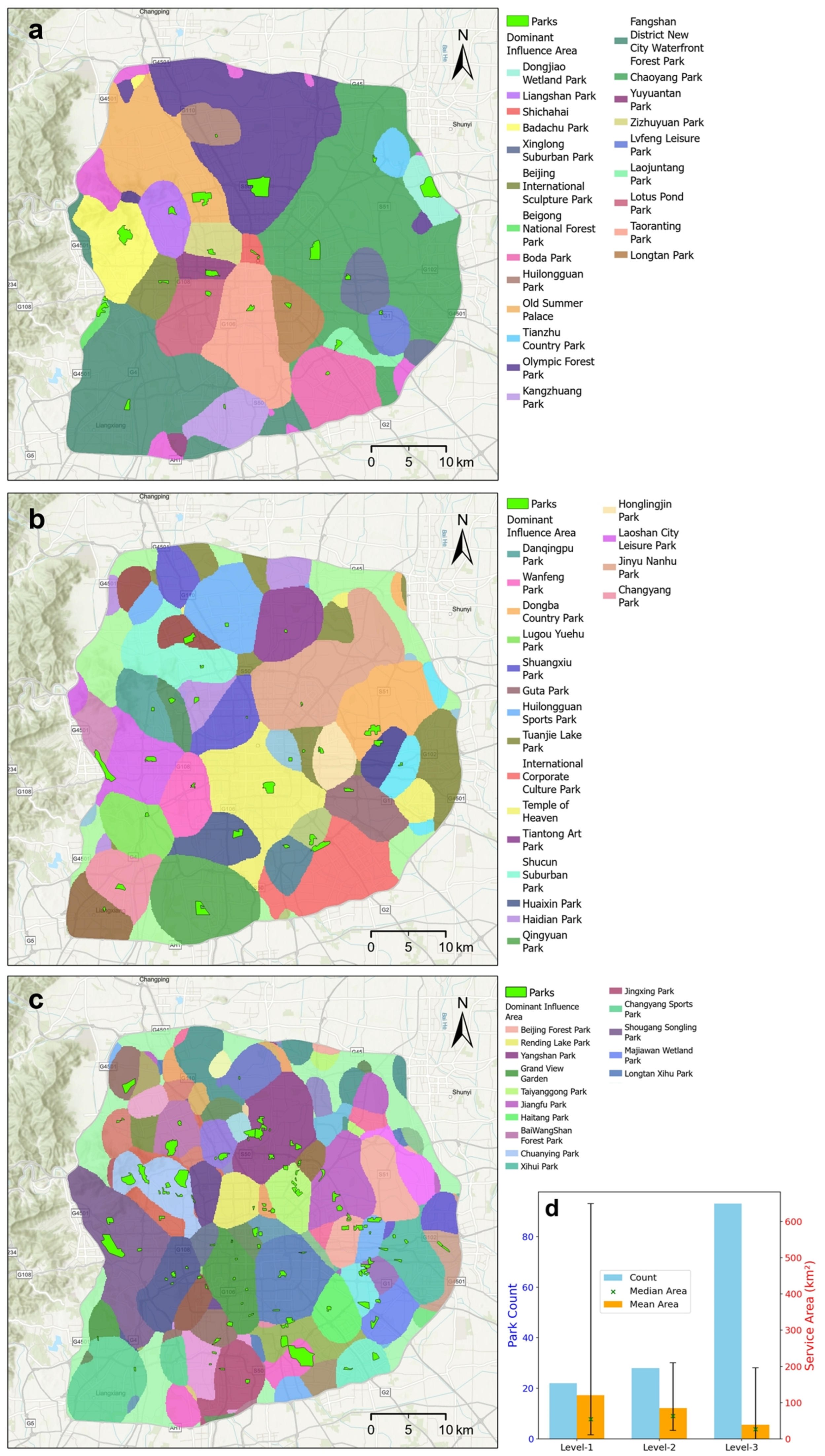
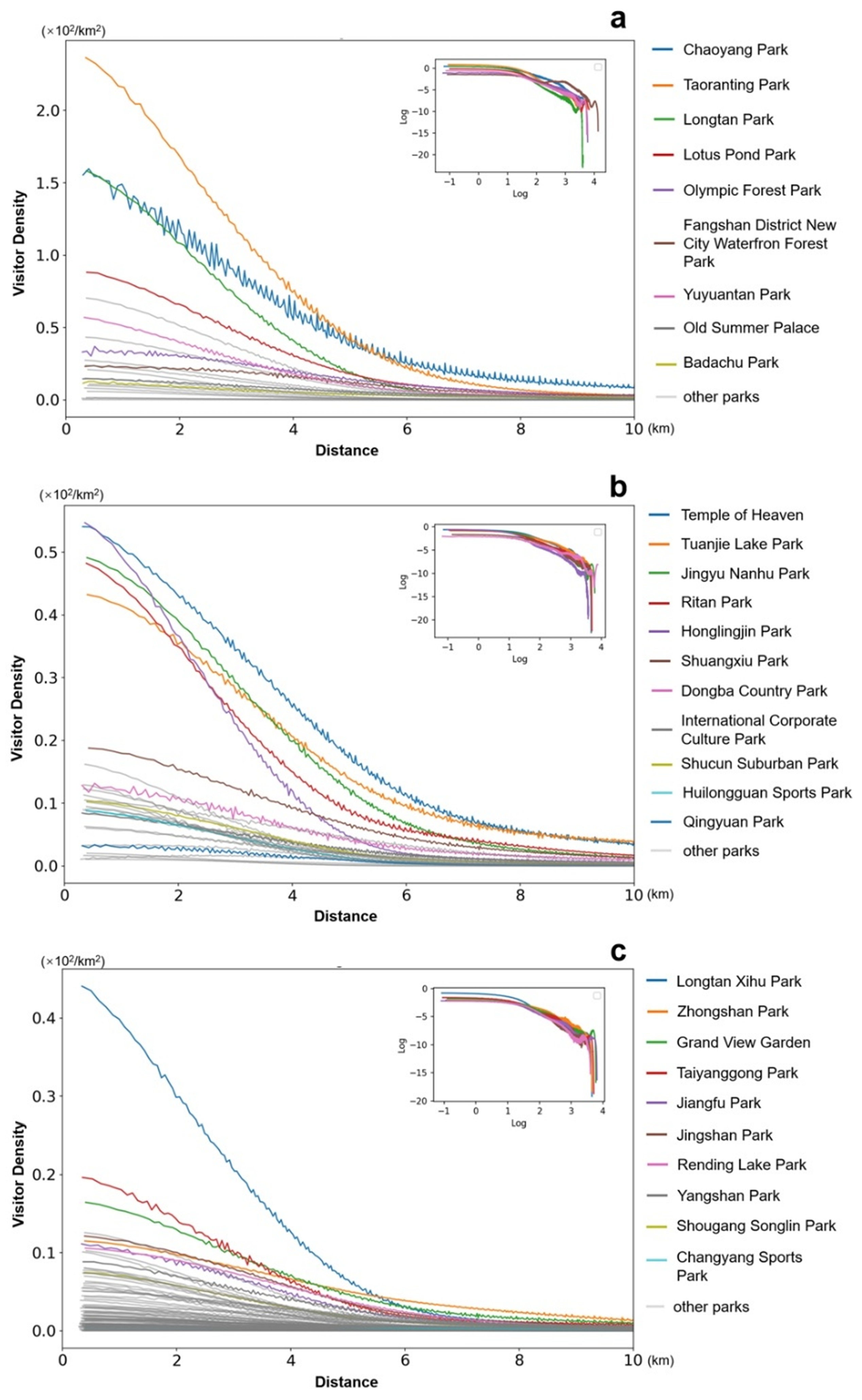
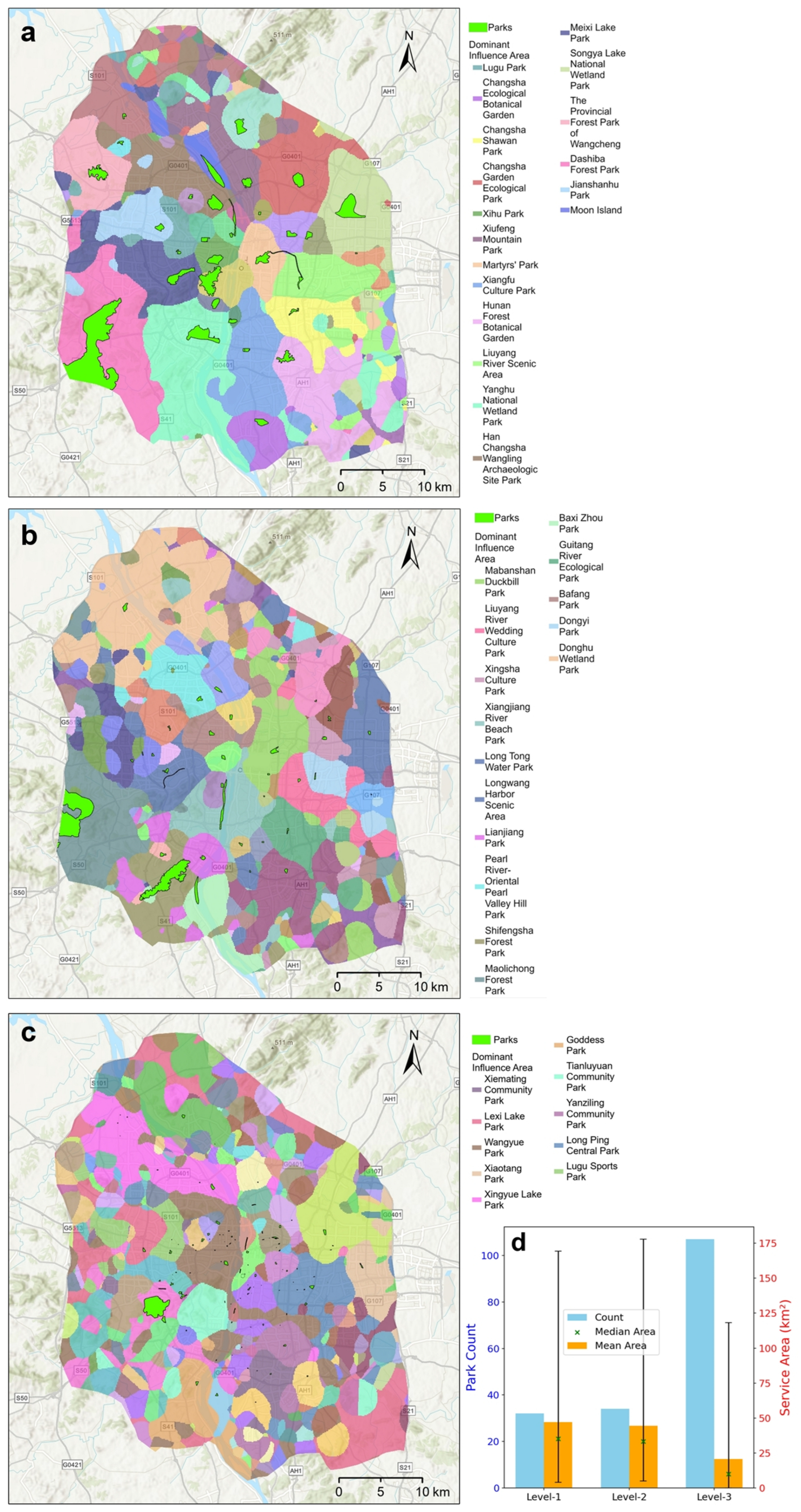
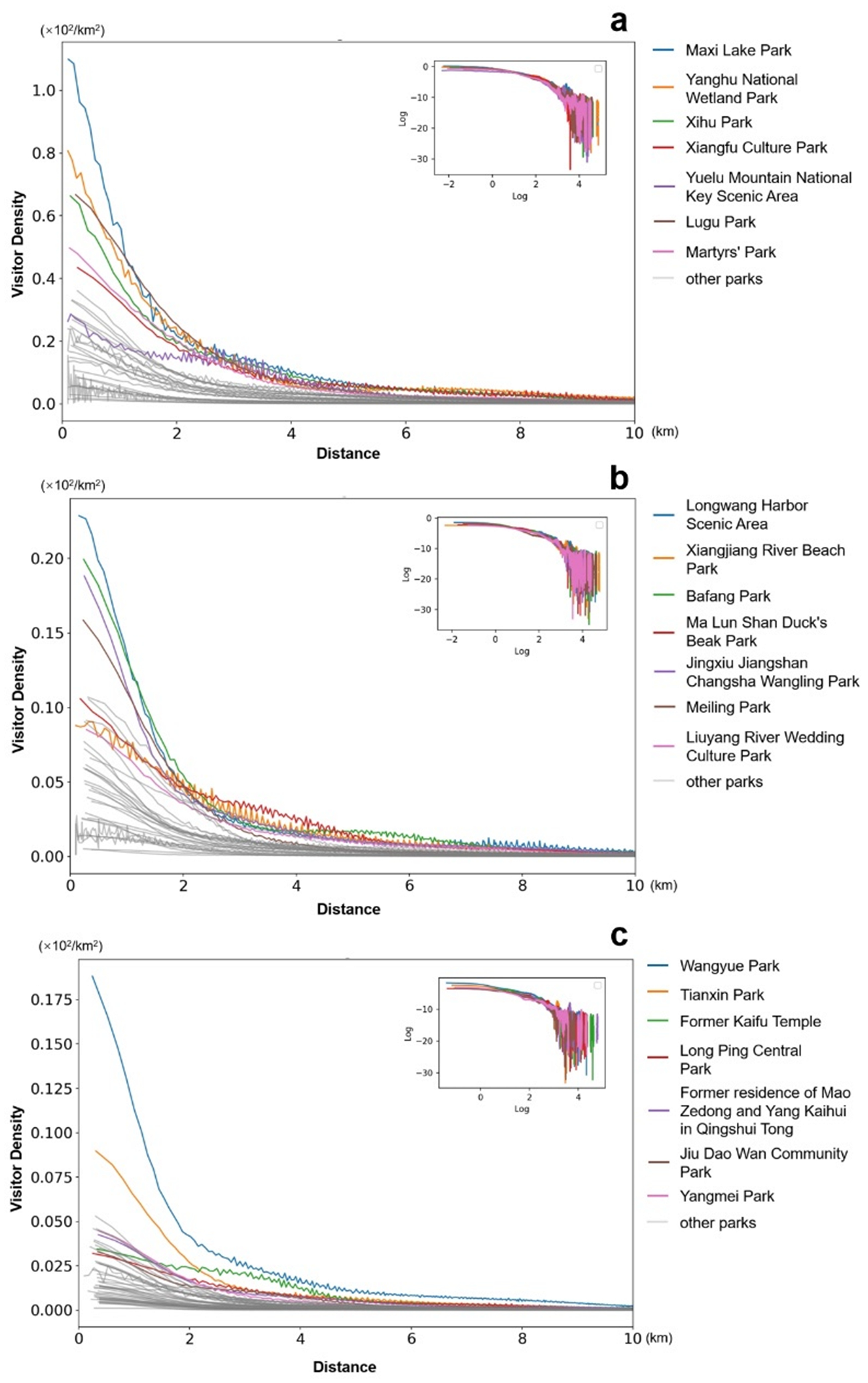

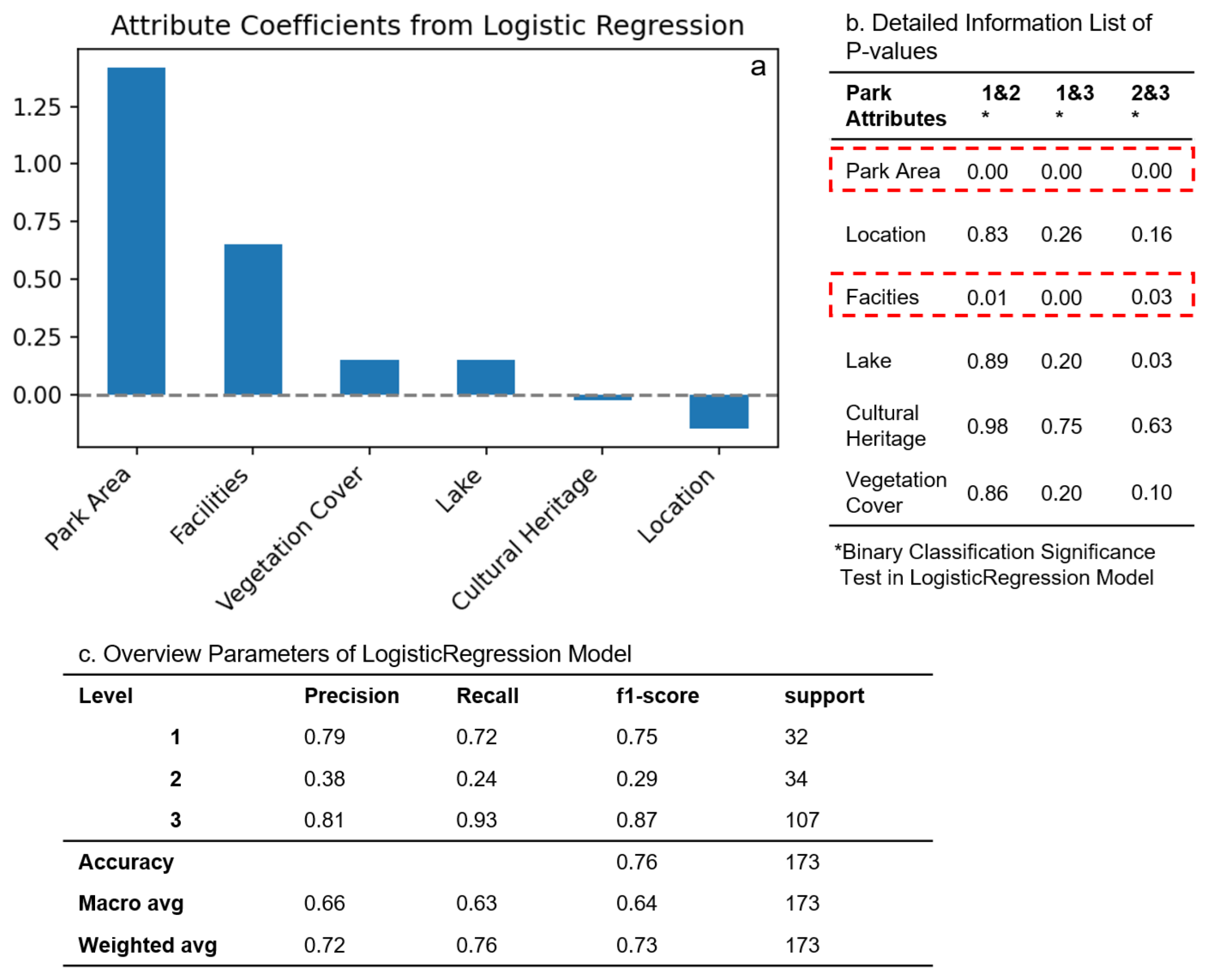
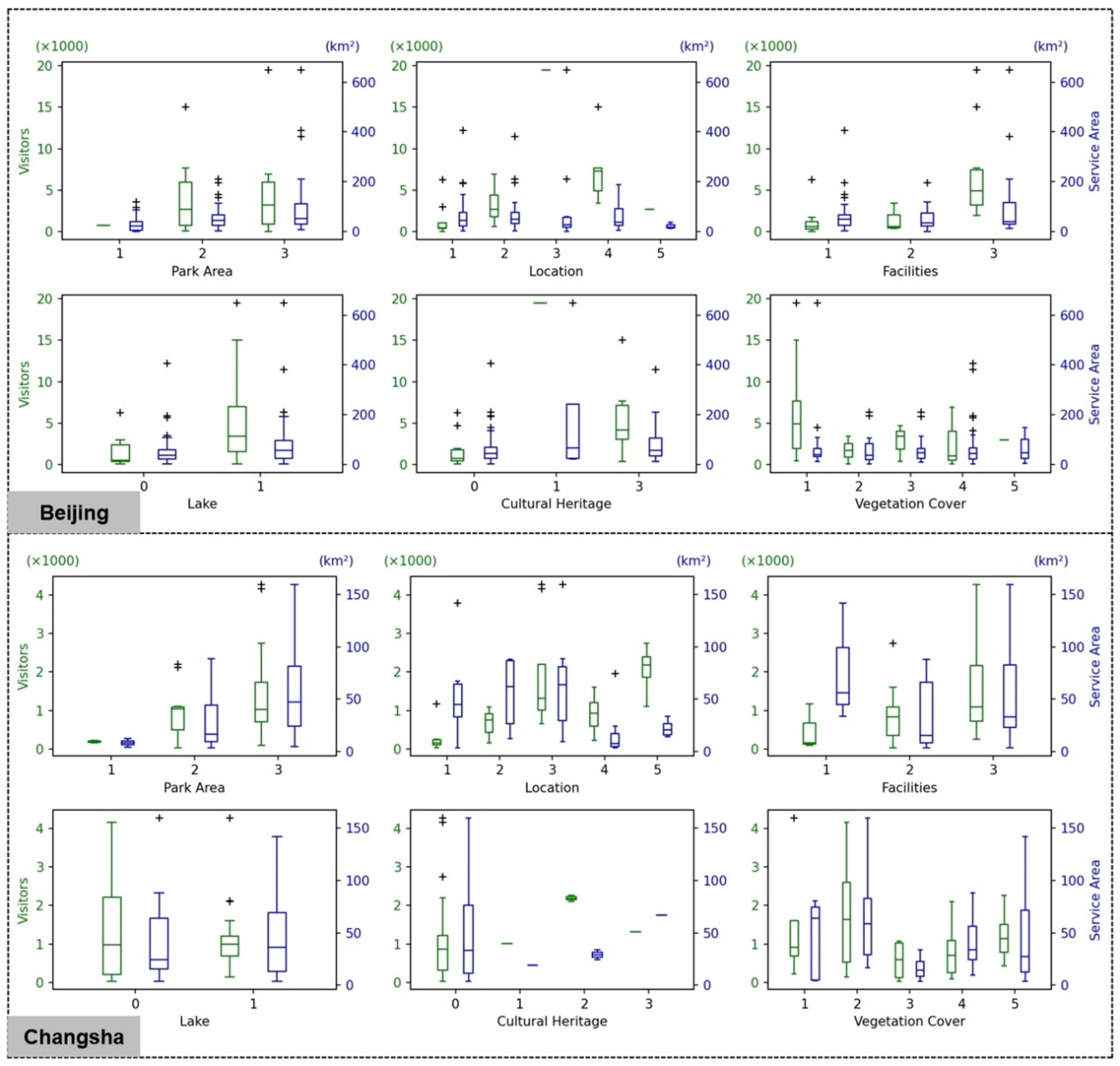

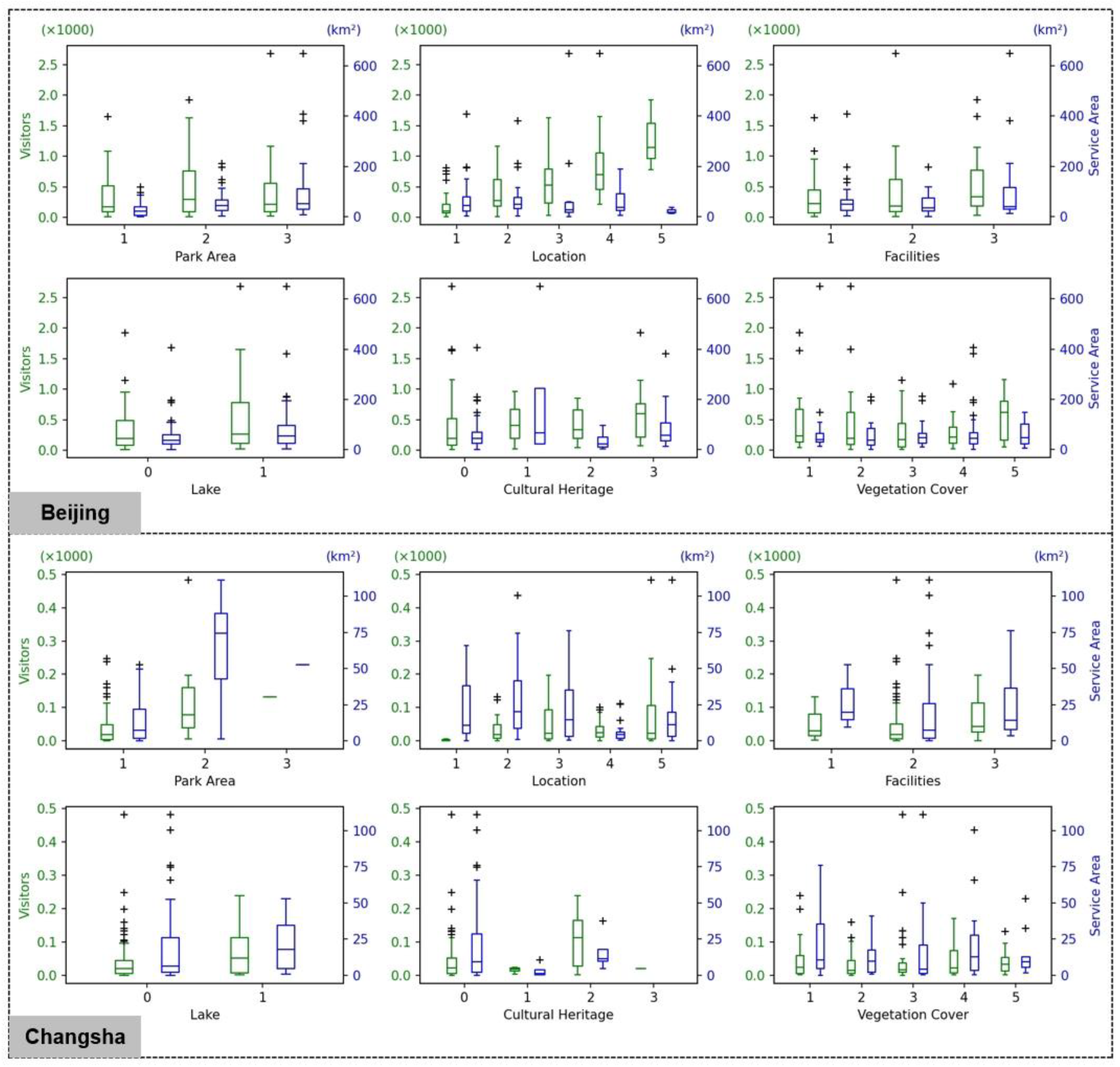
| Properties | Grading | Grading Basis |
|---|---|---|
| Area | ① 1–10 ha; ② 10–50 ha; ③ >50 ha | [27] |
| Facilities | ① support large-scale outdoor activities; ② support regular sports like basketball ③ basic facilities | Downloaded through an API from https://lbs.amap.com/ (accessed on 3 March 2020) |
| Lake | ① with lake; ② without lake | Interpretation from remote sensing data |
| Cultural heritage | ① heritage-less; ② regular heritage; ③ history relics; ④ lager-scale former industrial sites | Obtained from the Internet |
| Vegetation cover | ① low; ② medium–low; ③ medium; ④ medium–high; ⑤ high | Extracted from remote sensing data |
| Location | Five categories from Second to Sixth Ring Road | The centroid location of parks |
Disclaimer/Publisher’s Note: The statements, opinions and data contained in all publications are solely those of the individual author(s) and contributor(s) and not of MDPI and/or the editor(s). MDPI and/or the editor(s) disclaim responsibility for any injury to people or property resulting from any ideas, methods, instructions or products referred to in the content. |
© 2025 by the authors. Licensee MDPI, Basel, Switzerland. This article is an open access article distributed under the terms and conditions of the Creative Commons Attribution (CC BY) license (https://creativecommons.org/licenses/by/4.0/).
Share and Cite
Wen, N.; Yin, H.; Ma, Z.; Peng, J.; Tang, K.; Yao, D.; Xiang, G.; Xu, L.; Ye, J.; Yu, H. Central Place Theory Based on Mobile Signal Data: The Case of Urban Parks in Beijing and Changsha. Land 2025, 14, 673. https://doi.org/10.3390/land14040673
Wen N, Yin H, Ma Z, Peng J, Tang K, Yao D, Xiang G, Xu L, Ye J, Yu H. Central Place Theory Based on Mobile Signal Data: The Case of Urban Parks in Beijing and Changsha. Land. 2025; 14(4):673. https://doi.org/10.3390/land14040673
Chicago/Turabian StyleWen, Ning, Hang Yin, Zhanhong Ma, Jiajie Peng, Kai Tang, Deyi Yao, Guangxin Xiang, Liyan Xu, Junyan Ye, and Hongbin Yu. 2025. "Central Place Theory Based on Mobile Signal Data: The Case of Urban Parks in Beijing and Changsha" Land 14, no. 4: 673. https://doi.org/10.3390/land14040673
APA StyleWen, N., Yin, H., Ma, Z., Peng, J., Tang, K., Yao, D., Xiang, G., Xu, L., Ye, J., & Yu, H. (2025). Central Place Theory Based on Mobile Signal Data: The Case of Urban Parks in Beijing and Changsha. Land, 14(4), 673. https://doi.org/10.3390/land14040673







